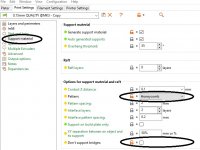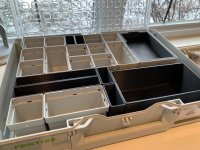simnick said:
This thread inspired me to finally pick up a 3d printer. My Artillery X1 arrives tomorrow. Your bins will be some of the first things I try. Any advise or resources to point me to for getting started with my 3d printer? What slicer are you using?
Oh man, that's awesome! I've seen prints from the X1 in person and they are fantastic!
My advice to anyone getting started in 3D printing:
1. Free files to print and search are available on
Thingiverse There are a lot of other sites like this too these days; Cults, Yeggi, and paid sites like CGTrader, Do3D....
2. Learn Fusion360 early, its free! and you now need a login from its parent company Autodesk to check your files to ensure they are manifold (watertight) using the free
Netfabb service. There are a lot of paid Fusion360 courses available, some tailored to woodworking, etc., but Kevin Kennedy on YouTube has a
Learn Fusion 360 in 30 Days for Beginners YouTube playlist that is completely free and where I learned it. Google Lars Christensen for additional free resources; he works for Autodesk
3. Slicer. I use the PRUSA Slicer that came with my printer, but it works with all printers (as far as I know, you can configure it to show the Artillery build plate, etc). Its very easy to use (and free!), though it is not the only good one around these days.
4. Check out Angus Deveson at
Makers Muse for advice, reviews, tests, neat stuff, etc. He is an OG 3D printer and still going strong with great content.
5. Run any file you pull off a free site (and even the ones you've created) through the free
Netfabb service referenced above. This repairs any file found to be non-manifold. There's nothing worse than coming back to a 24-hour print and finding a giant spaghetti mess of hardened plastic caked all over your printhead and print bed because your model wasn't manifold and the printer was trying to print in mid-air.
6. Have supports enabled via your slicer for anything that overhangs at greater than a 45-degree angle (most slicers have an automatic support option). You can change all sorts of parameters here, using stronger honeycomb supports, rectilinear, etc.. over time you will know when you need and don't need supports.. and you can "paint" them in manually as well
7. You don't need to use high infill percentages. 15% is very common and saves you filament. More infill = stronger prints though, and I use the gyroid infill pattern, as it saves plastic and is still strong.. you can find videos of strength tests from
CNC Kitchen
8. There are a pile of filaments out there; PLA being the most common. Its also corn-based and actually smells alright, ha ha. ABS, Nylon, Carbon-fibre reinforced stuff, flexible stuff (NinjaFlex).. and all kinds of variants. Your slicer will likely automatically adjust your settings when you input what brand/type you're using but the roll of filament or the box will also have suggested settings. The highest quality prints I've ever achieved were from a roll of PRUSAment filament that came with my printer, but I usually use generic 2kg rolls of PLA because its cheap and still has great print quality. If you're in Canada you can use the code 52021FDC to get 5% off at
Filaments.ca. I told them earlier this week I was making a 3D printing video on YouTube and asked if they would share a discount code, and they did! 5% not huge, but its a start

(I'm sure Seth will let me know if this is allowed on the forum... I get no money from them and have no affiliation.. I just asked and and they gave it [laughing])
9. Setting up a print for the first time, calibrating your bed, your first layer height, etc. is a trial and error process, but once dialed in you should be good. Try not to get too frustrated during this process.
10. Be safe. Your hot end is typically melting the plastic at 215C or higher, there have been fires from controllers and hotends.. a smoke detector would be great. You can also connect a webcam to almost any printer these days (free plans online) and watch your prints from your phone with Octoprint... you can do timelapses, etc, too.. I've printed PLA indoors, but typically do it in my garage on a steel benchtop (and have NEVER had any problems with the smell or fires). I've seen an Artillery (printer brand) operating on a dining room table for hours on end with no issues and no bad smells; but to each their own.
11. Failed prints happen, for a variety of reasons. Software and printers these days are much better at detecting and correcting these, but be prepared for occasional frustration. Such is life.
Good luck! ;D
12. Oh, forgot this one. You can use a conventional mouse for everything in Fusion360 and your slicer program, BUT a Space Mouse from
3DConnexion is AMAZING for improving your workflow and "flying around" your model and the screen. I have the SpaceMouse Wireless so I can use it on my desktop or laptop. It gets used by my left hand, while my right uses the conventional mouse. It comes with its own "training" app to get you fluent quickly, which was a nice touch too.
EDIT: 13. If you come back to your printer and find a failed print and a huge blob of hardened plastic encasing your hotend, don't just try and pry/cut it off. Heat up the hotend first ("Load filament" setting on your printer) and then just pull it off slowly. The first time this happened to me I accidently ripped off the wires connecting to my hotend. Oh, and depending on your printer, almost every tiny little part is available for purchase separately and very inexpensively. You can also print your own parts in many instances, or have a friend print them if yours is out of commission.
EDIT: 14: 3D Printer recommendations:
ALL3DP Best Printers (as of Feb.2021)
I've owned or been in close contact with three of their top choices (across different price categories) so in my opinion, its a credible source.





